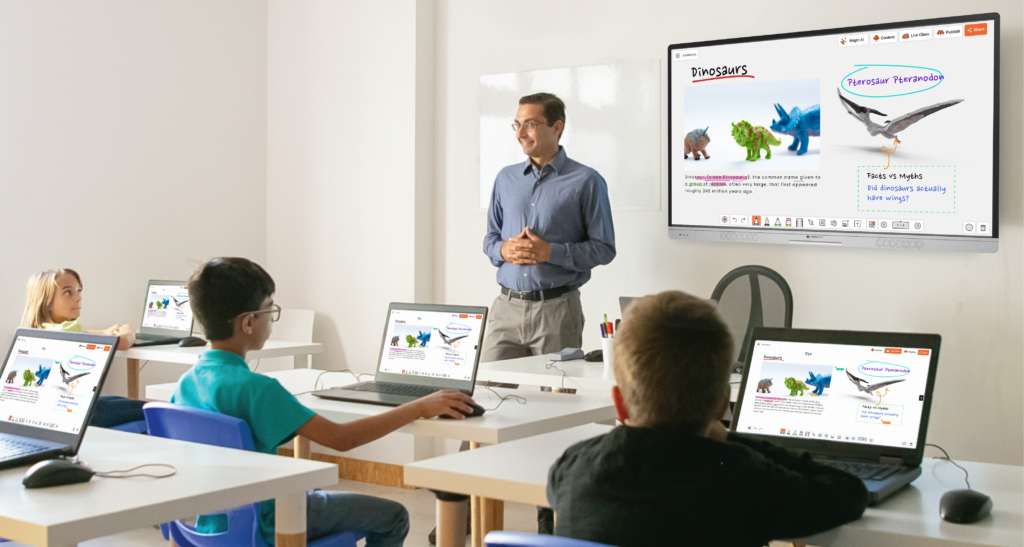
- 2024-07-29
The Ultimate Guide to Understanding Interactive Flat Panels
Description
A brief overview of interactive flat panels (IFPs) and their growing popularity in various settings
Interactive Flat Panels (IFPs) have emerged as a revolutionary tool for modernizing classrooms in the education sector. These displays build upon the concept of traditional whiteboards by integrating touch technology and interactive capabilities. They allow educators to present content dynamically, annotate materials, and engage students directly. The history of IFPs traces back to the early 2000s when interactive whiteboards began to gain popularity. Over time, advancements in touch technology and display quality led to the development of IFPs, which offer larger, brighter screens with enhanced interactivity. This evolution has made IFPs a staple in modern classrooms, fostering active learning, collaboration, and tech-driven engagement among students and teachers.
Understanding Interactive Flat Panels
1.1 What are Interactive Flat Panels?
Interactive flat panels are cutting-edge displays that redefine learning by merging high-resolution visuals with touch interactivity. Spark engagement as students directly interact with content using intuitive gestures, turning lessons into captivating experiences. IFPs cultivate collaboration, enabling seamless group activities and dynamic idea sharing. Teachers wield these panels as innovative instruments, effortlessly accessing teaching aids, online resources, and interactive tools.
Additionally, IFPs encourage student participation, as learners can directly interact with the content, fostering critical thinking and problem-solving skills. Their integration with digital resources and internet connectivity opens access to up-to-date information. IFPs enhance pedagogical practices, making learning more dynamic, inclusive, and aligned with the digital age. Beyond classrooms, IFPs elevate teaching styles, making data and ideas come alive. Seamlessly blending technology with education, IFPs empower institutions to stay ahead in a rapidly evolving world.
1.2 Benefits of Interactive Flat Panels: Enhancing Learning and Collaboration
Interactive Flat Panels (IFPs) bring many advantages to educational context reshaping how information is presented, absorbed, and shared.
Improved Visual Learning and Information Retention:
- High-resolution displays offer clear, vivid visuals that aid in conveying complex concepts.
- Multimedia integration, including animations and videos, enhances comprehension and retention.
- Visual stimuli cater to diverse learning styles, making information more accessible.
Collaborative Opportunities for Teachers and Students:
- Real-time annotation capabilities encourage interactive discussions and brainstorming.
- Multi-user support enables team members to contribute simultaneously, fostering collaboration.
- Seamless content sharing enhances idea exchange, creativity, and problem-solving.
Reduction of Equipment Clutter:
- IFPs consolidate multiple functionalities (display, touch, and audio) into a single device.
- Eliminates the need for separate projectors, whiteboards, and audio systems.
- Streamlining setup saves space and reduces the complexity of equipment arrangement.
1.3 Applications of Interactive Flat Panels: Revolutionizing Learning and Training
Education Sector: Transforming Classrooms and Remote Learning:
- Classroom Dynamics Enhancement: IFPs bring interactivity, multimedia, and engagement to traditional classrooms. Educators can illustrate concepts dynamically, encouraging student participation and active learning.
- Remote Learning Revolution: IFPs facilitate seamless virtual education. Teachers can conduct interactive lessons remotely, annotate content, and maintain student engagement, replicating in-person classroom experiences.
- Customized Learning: IFPs cater to different learning styles. Students can interact with content, collaborate on projects, and access digital resources for personalized learning journeys.
Training and Workshops: Interactive Training Sessions:
- Engaging Learning Experience: IFPs make training sessions captivating. Trainers can use touch-enabled features to enhance presentations, keeping participants engaged and focused.
- Real-time Interaction: Using the interactive touchscreen, participants can directly interact with training materials, ask questions, and contribute ideas.
- Collaborative Learning: IFPs encourage group activities and problem-solving during workshops. Participants can collectively work on tasks and share insights, fostering a collaborative learning environment.
In education, they reshape traditional classrooms and facilitate remote learning, offering customized learning experiences. IFPs make sessions more engaging, interactive, and collaborative for training and workshops, elevating knowledge dissemination and skill development effectiveness.
Components and Features of Interactive Flat Panels
2.1 Display Quality: Enhancing Visual Experience and Interaction
Resolution and Image Clarity:
- High-Definition Visuals: Interactive Flat Panels (IFPs) offer high-resolution displays that ensure sharp, clear images and text.
- Vivid Details: Higher pixel density improves clarity, enhancing the presentation of intricate visuals and graphics.
- Enhanced Visual Communication: Crisp visuals aid in conveying complex concepts, ensuring information is easily comprehensible.
Size Options and Viewing Distance Considerations:
- Diverse Size Range: IFPs come in various sizes, catering to different room dimensions and audience sizes.
- Optimal Viewing Experience: Choosing the right size based on the room’s layout ensures all participants have a clear view, preventing eye strain.
- Suitable for Large Settings: Larger IFPs are ideal for auditoriums and larger classrooms, guaranteeing visibility for everyone present.
Touch Responsiveness and Accuracy:
- Precise Touch Technology: IFPs use advanced touch-sensitive technology for accurate interaction.
- Seamless Interaction: Touchscreens respond quickly to touch gestures, enabling smooth navigation and annotation.
- Enhanced User Experience: Fluid touch responsiveness enhances engagement, making interactions intuitive and efficient.
The display quality of IFPs plays a pivotal role in delivering impactful presentations and interactive experiences. High resolution, appropriate size choices, and responsive touch technology collectively ensure a visually immersive and interactive environment conducive to effective communication and learning.
2.2 Touch Technology: Enhancing Interactive Experiences
Interactive Flat Panels (IFPs) rely on sophisticated touch technologies to create seamless and responsive interactions, making them a cornerstone of modern education and collaborative environments. Several touch technologies are used to power these interactions, each with its unique advantages.
1. PixelTouch Technology (Optical Touch Technology):
- Precise Touch Tracking: PixelTouch technology employs invisible grids projected by emitter/sensor modules within the display frame. This enables accurate tracking of touch, gestures, and hover inputs without compromising the aesthetics of the panel.
- Real-time Optical Imaging: Advanced optical imaging and algorithms ensure responsive and intuitive interactivity, enhancing user engagement.